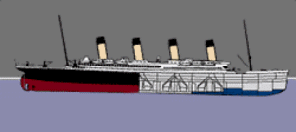
 |
The ship was a victim of rust, says Robert Baboian, the retired director of Texas Instruments' corrosion lab. The Titanic was held together by 3 million rivets made with a different type of iron than the hull plates, he notes. And once the hull was finished, the ship sat in seawater for a year while the inside was furnished. The dissimilar metals of the hull and rivets, bathed in electrically conductive seawater, might have created a circuit that slowly flecked away and weakened the rivets. One of the last photos taken before the ship's maiden voyage shows a pattern that suggests the rivets were rusting faster than the hull plates, says Baboian.

The Titanic collision with the iceberg could have popped the weakened rivets, which would explain a clinking sound reported by survivors. The hull did not rip open, but a long opening just an inch wide between the hull plates could have sunk the ship. Video of the wreckage shows a narrow opening in the unburied part of the bow, Baboian says: "It is about at the level where the iceberg would have struck, and it is right where rivet popping could occur. I think that caused the Titanic to sink." Baboian points out that the following information supports his theory that corrosion contributed to the sinking of the Titanic:
She was launched to be fitted out at dockside almost a year before her maiden voyage,
During the year in seawater, there is a strong possibility that stray currents from DC equipment caused accelerated corrosion,
The rivet iron was different from the hull plate iron by design. The rivet iron needed to be maleable and therefore consisted of a higher level of slag inclusions,
During the year at dockside, corrosivity of the rivet iron could therefore have been higher than the hull plate iron. Galvanic corrosion of the rivet iron is likely during that period of time,
Photos and video taken by Robert Ballard during his 1985 and 1986 expeditions to the Titanic show preferential corrosion of the rivets in some areas,
Inspection of the "big piece" which was retrieved from the ocean bottom also shows this same preferential corrosion in some areas. All of this evidence points towards weakening of the hull/rivet structure, enhancing the rivet popping mechanism which caused the Titanic to sink,
Discover, Vol. 22, No 8 (August 2001)